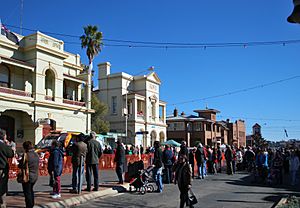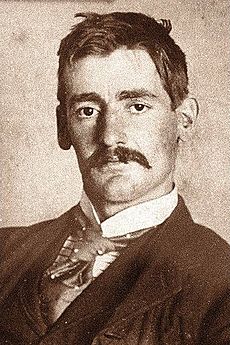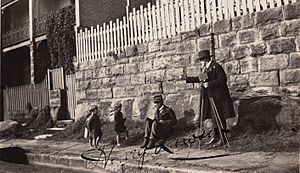Henry Lawson facts for kids
Quick facts for kids
Henry Lawson
|
|
|---|---|
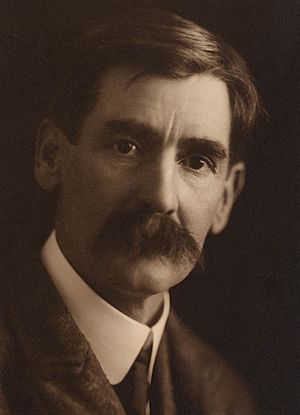
Lawson c. 1915
|
|
| Born |
Henry Archibald Hertzberg Lawson
17 June 1867 Grenfell, New South Wales, Australia
|
| Died | 2 September 1922 (aged 55) Sydney, New South Wales, Australia
|
| Occupation | Author, poet, balladist |
| Spouse(s) |
Bertha Marie Louise Bredt
(m. 1896; div. 1903) |
| Children | 2 |
| Relatives |
|
Henry Archibald Hertzberg Lawson (born June 17, 1867 – died September 2, 1922) was a famous Australian writer and bush poet. Many people consider him one of Australia's best short story writers. He is known alongside his friend and fellow writer, Banjo Paterson.
Lawson was a strong supporter of Australian pride and a republic. He often wrote for a magazine called The Bulletin. His stories and poems helped make Australian everyday language popular in books. He wrote a lot in the 1890s, but then wrote less because he faced personal challenges. He sometimes struggled financially and spent time in places like prison. After he passed away in 1922, Henry Lawson was the first Australian writer to be given a special state funeral.
His mother was Louisa Lawson, who was also a poet, publisher, and a supporter of women's rights.
Contents
Henry Lawson's Early Life
Henry Lawson was born on June 17, 1867, in a town called Grenfell in New South Wales, Australia. This town was known for its goldfields. His father, Niels Hertzberg Larsen, was a miner from Norway. Niels came to Australia in 1855 to join the gold rush.
Henry's parents, Niels and Louisa Albury, met at the goldfields. They got married in 1866. When Henry was born, his family's last name was changed to Lawson. His parents had a difficult marriage. Louisa later became very involved in women's rights. She even started her own newspaper for women called The Dawn. She also published Henry's first book and her own poems. Louisa likely had a big impact on Henry's writing when he was young.
How Did Deafness Affect Lawson?
Henry started school in 1876. Around this time, he got an ear infection. This made him partly deaf, and by the time he was 14, he couldn't hear at all. His teacher, John Tierney, was kind and helped Henry, who was very shy. Henry later went to a Catholic school in Mudgee, where his teacher taught him about poetry.
Henry loved to read books by authors like Dickens and Marryat. He also read Australian novels such as For the Term of His Natural Life and Robbery Under Arms. Reading became a very important part of his education because his deafness made it hard for him to learn in a classroom.
In 1883, Henry moved to Sydney to live with his mother. He worked during the day and studied at night, hoping to go to university, but he didn't pass his exams. He also spent time in Newcastle, working and visiting the School of Arts to keep learning. When he was about 20, he went to a hospital in Melbourne for his deafness, but nothing could be done.
In 1896, Henry Lawson married Bertha Bredt. They had two children, a son named Jim and a daughter named Bertha. Their marriage ended in 1903.
Henry Lawson's Writing Career
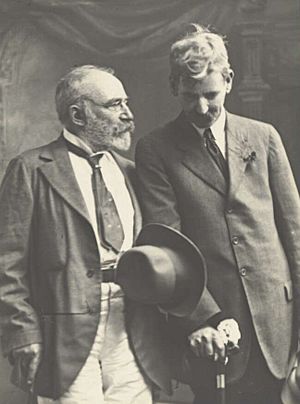
Henry Lawson's very first poem, 'A Song of the Republic', was published in The Bulletin magazine in 1887. His mother's friends, who supported a republic, influenced him. The magazine mistakenly said he was 17, but he was actually 20.
In 1890-1891, Lawson worked in Albany. He then got a job writing for a newspaper in Brisbane, but it closed down after a few months. He returned to Sydney and kept writing for the Bulletin. In 1892, the Bulletin paid for him to travel inland. This trip showed him the harsh reality of the Australian countryside during a drought. He also worked on a sheep station.
This journey was very important for his writing. It showed him that the Australian bush was not a romantic, beautiful place like some poets, such as Banjo Paterson, described. Instead, he saw the tough, lonely side of the outback.
What Was Lawson's Writing Style?
Lawson's most famous collection of stories is While the Billy Boils, published in 1896. In this book, he continued to show the real side of Australia. He used short, clear sentences and simple language. His writing style was direct and honest, like that of later writers such as Ernest Hemingway.
Lawson's stories often focused on the Australian bush. Many people believe his descriptions were some of the first accurate pictures of Australian life at that time. His story "The Drover's Wife" is a great example. It shows the sadness and loneliness of life in the bush and is often studied in schools.
Lawson believed that short, simple stories, called 'sketches', were the best kind of writing. His story On the Edge of a Plain is a good example of his sketch style. Even though Lawson lived in a city, he had a lot of experience in the outback, and many of his stories came from his real-life adventures. In Sydney, he was part of a group of writer friends who met to talk and share ideas.
Henry Lawson's Later Life

In 1903, Henry Lawson moved into a room at Mrs. Isabel Byers' Coffee Palace in North Sydney. This began a 20-year friendship between them. Even though he was Australia's most famous writer, Lawson was often sad and always poor. He didn't get much money from his books because of bad deals with publishers. He spent time in Darlinghurst Gaol (a prison) several times between 1905 and 1909, usually due to financial difficulties. He wrote a poem called "One Hundred and Three" (his prison number) about his time there. He called the prison "Starvinghurst Gaol" because of the small amount of food given to prisoners.
During this time, Lawson became withdrawn and found it hard to live a normal life.
Mrs. Byers was also a poet. She saw Lawson as Australia's greatest living poet and wanted to help him keep writing. She helped him with publishers, arranged for him to see his children, found friends to help him financially, and supported him through his personal challenges. She wrote many letters for him and tried to find him money or publishing deals.
Henry Lawson passed away from a brain bleed in 1922 at Mrs. Isabel Byers' home in Abbotsford, Sydney. He was given a special state funeral. The Prime Minister, Billy Hughes, and thousands of people attended his funeral. He was buried at Waverley Cemetery. Lawson was the first person to receive a state funeral in New South Wales just for being a 'distinguished citizen'.
Henry Lawson's Legacy
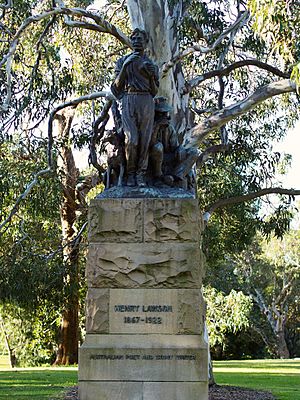

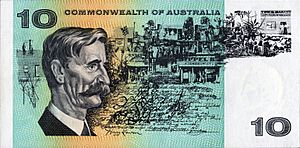
There is a bronze statue of Henry Lawson in The Domain, Sydney. It shows him with a swagman (a traveling worker) and a dog, which represent his writing. People donated money to create this statue, which was unveiled in 1931.
Henry Lawson has been honored on Australian postage stamps several times, starting in 1949. His famous short story "The Drover's Wife" was featured on stamps in 1991 and 2017.
From 1966 to 1993, Henry Lawson's picture was on the back of the first Australian ten-dollar banknote. The note also showed scenes from the town of Gulgong in New South Wales.
Some people have discussed how Lawson wrote about Aboriginal Australians in his work. Author Ryan Butta has pointed out that Lawson's writings about Bourke don't mention the Afghan cameleers who were important at that time for exploring the Australian interior.
Famous Works by Henry Lawson
- "Faces in the Street" (poem, 1888)
- "Andy's Gone with Cattle" (poem, 1888)
- "The Teams" (poem, 1889)
- "Freedom on the Wallaby" (poem, 1891)
- "The Bush Undertaker" (short story, 1892)
- "The City Bushman" (poem, 1892)
- "Up The Country" (poem, 1892)
- "The Drover's Wife" (short story, 1892)
- "The Union Buries Its Dead" (short story, 1893)
- "The Loaded Dog" (short story, 1901)
- "A Child in the Dark, and a Foreign Father" (short story, 1902)
- "Scots of the Riverina" (poem, 1917)
See also
 In Spanish: Henry Lawson para niños
In Spanish: Henry Lawson para niños


